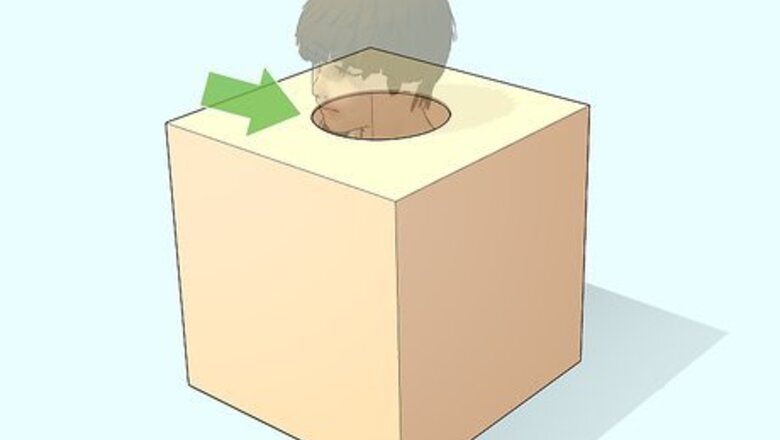
views
Forming the Giraffe’s Body
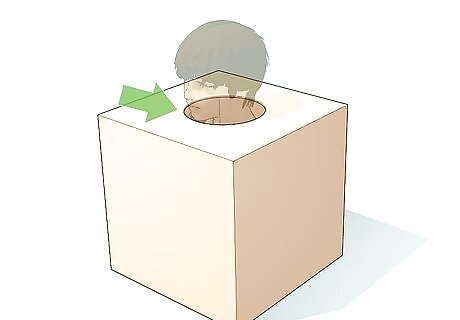
Cut a head sized hole in the bottom center of a box. The box you use should be large enough for your upper body to fit into and it should be open on the top and closed on the bottom. Trace a circle onto the bottom center of the box that is about 4 inches (10 cm) larger in diameter than the opening of one of your t-shirts. Then, cut along this circle to create the hole. Try to place your head through the hole to ensure that it is large enough. Poke your scissors into the bottom of the box to get the hole started and then cut around the lines you have traced. You may want to reinforce the box with a couple of strips of masking tape to ensure that it remains sturdy after you cut out the hole.
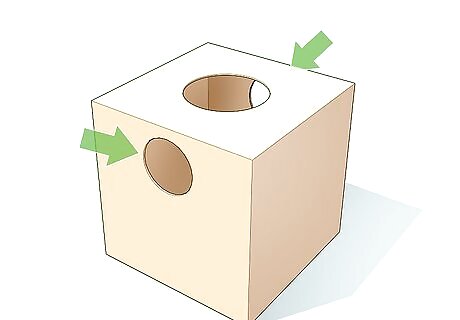
Cut 1 hole on each side of the box where your arms will go through. Put the box over your upper body with your head through the hole in the bottom of the box. Identify the best location for the armholes. Then, remove the box and cut out the armholes. Make sure that the armholes are large enough for your arms to fit through comfortably. Try on the box after cutting the holes to ensure that they are big enough.

Cut a long strip out of one of your large pieces of poster board. You will need 2 pieces of flexible poster board large enough to wrap around your head with some overlap. Take one of your large pieces of poster board and cut off a strip that is about ¼ of the total width of the poster board. For example, if the poster board is 36 inches (91 cm) wide, then cut a strip that is 9 inches (23 cm) wide. Set this strip aside. You will need it to make the giraffe’s head.
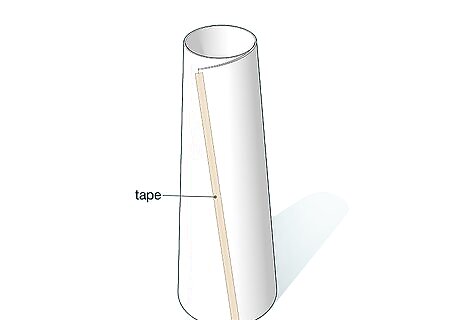
Roll the intact poster board into an open cone shape and secure it with tape. Take the large poster board piece that you did not cut and roll it up to form a cone. Your head should fit comfortably into the bottom half of the cone, but it should be narrower towards the top. The bottom of the poster board should also be the same size as the opening on your box that you will fit your head through, so check before you tape it up. Place a long strip of masking tape along the edge of the cone to secure it in this shape. The cone should not come to a point at the top, but remain slightly open. The shape you are going for is halfway between a cone and a cylinder shape.
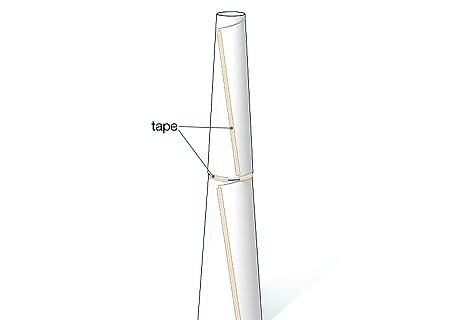
Wrap the second piece of poster board around the top of the open cone. Next, take the other large piece of poster board that you cut. Wrap it around the top portion of the other open cone. The bottom of the second piece should begin about 3 inches (7.6 cm) from the end of the cone top of the first piece. Secure the cones together with a few strips of tape. Place a long strip of tape along the edge of the second cone and a couple more strips perpendicular to this piece. The second piece should be continuing the cone/cylinder shape of the first piece so that the giraffe’s neck is thicker towards the bottom and gets thinner as it approaches the end. The opening on the end of the cone will only be about 3 inches (7.6 cm) in diameter.
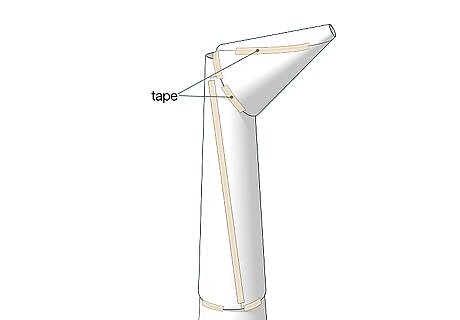
Form a cone with the long, thin piece of poster board to make the head. Take the long strip of poster board that you cut out and roll it to form a closed, pointed cone. Tape along the edge to secure the cone shape.

Tape the head, neck, and body pieces together. Tape the wide end of the cone to the hole you cut in your box so that the cone is oriented horizontally on top of the neck. Then, tape the wide end of the small cone to the end of the neck. The head piece should cover the open area of the top of the neck piece. Use as much tape as you need to secure the pieces together, but keep in mind that you will be applying paper mache over the pieces, so it is okay if they are a little loose.
Covering the Giraffe Form with Paper Mache
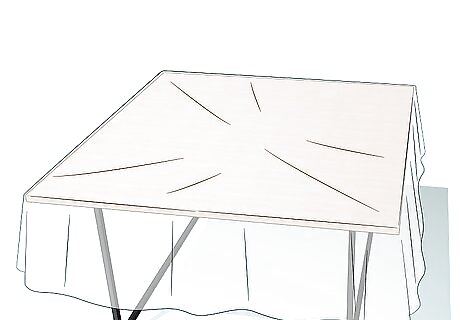
Protect your work surface. Paper mache can be very messy. Before you start covering the giraffe form with paper mache strips, cover the work surface with newspaper, paper towels, or a plastic tablecloth. You may also want to put on an old t-shirt and some pants you don’t mind getting dirty.

Mix the paper mache paste. To make paper mache paste with flour and water, mix together 1 c (240 mL) flour to 5 cups (1,200 mL) water and boil the mixture for 3 minutes. Then, let the solution cool and use it as your paste. To use glue and water, mix together 0.75 c (180 mL) of white glue with 0.25 c (59 mL) of water. Put the paste into a large bowl for easy dipping. You may need to make a double batch of paper mache paste for this project since you will be covering a large area.
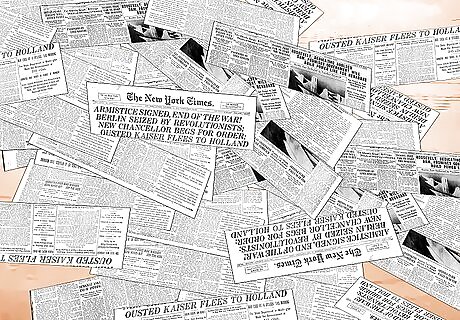
Tear up strips of newspaper. You will need lots of paper strips to cover the giraffe’s body, neck, and head. Take the newspaper and tear it into long and short strips of various widths to cover different parts of the giraffe. Place the strips in stacks on your work surface. You may also want to rip up some plain white paper or paper towels for the top layer of your paper mache. This will make it easier to paint the giraffe after the paper mache dries.
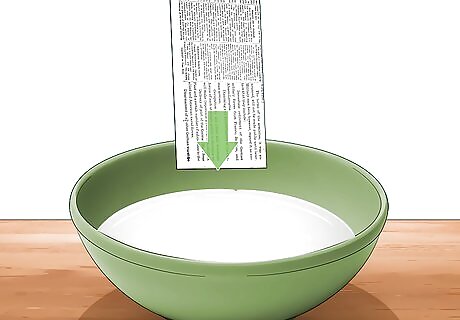
Dip a strip of newspaper into the paste. Take a strip of newspaper and press the whole strip into the bowl of paper mache paste so that it is fully immersed. Then, take the strip out of the paste, and let the excess drip off.
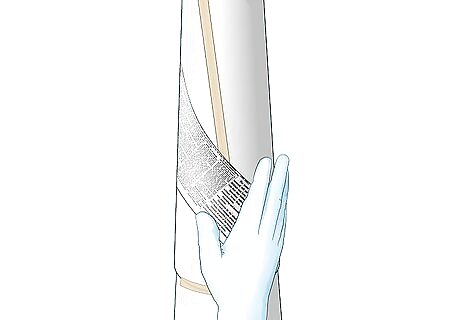
Apply the strip to the giraffe form. Apply the strip so it is diagonal on the giraffe’s body, neck, and head. Smooth out the strip as you apply it to avoid any bumps or bubbles in the paper.
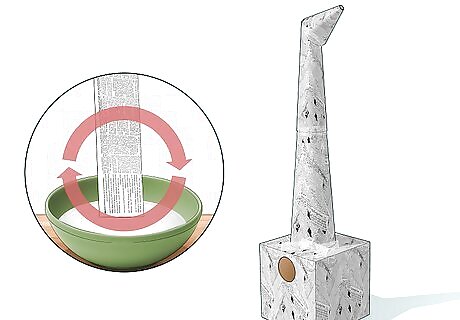
Continue to dip and apply strips until the giraffe form is covered. Do this while the previous layer is still wet. Apply your next strip so that is it overlapping the first strip by about 1 inch (2.5 cm). This will help to create a strong form for your giraffe costume. Keep applying the strips until the giraffe form is completely covered. Make sure to apply a couple of extra strips to the joints of the costume, such as at the base of the neck and where the neck and head connect. This will help to ensure that they are secure. You will need to apply at least 2 layers (but no more than 4 layers) of paper mache to the entire giraffe form.
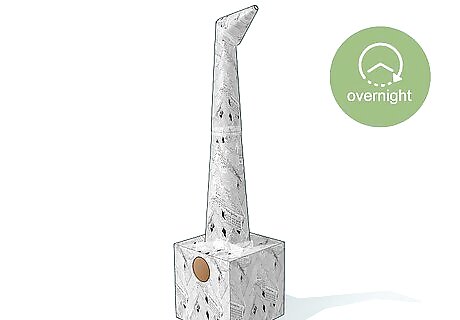
Let the paper mache dry overnight or longer. It takes a while for paper mache to dry completely, so plan to start your costume a few days before you need it. Avoid touching the paper mache while it dries. Place the form somewhere that it will not be disturbed by children or pets, such as in a closed room or garage.
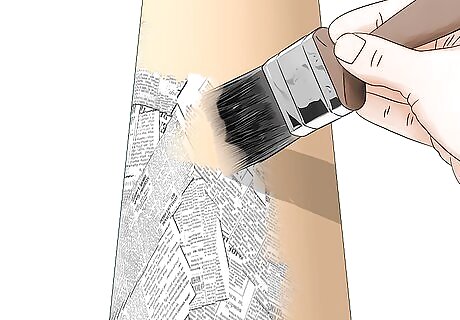
Paint the form yellow or tan after the paper mache dries. Create a base layer of yellow, cream, or tan acrylic paint depending on how you want your giraffe to look. For a more colorful giraffe, opt for yellow. For a more subdued or realistic giraffe, opt for tan or cream. Paint the entire head, neck, and body of the giraffe form. You may only need to paint 1 layer, but 2 layers of acrylic paint will provide better coverage. Wait for the first layer of paint to dry before adding a layer. Let the paint dry overnight.
Decorating the Giraffe’s Neck and Body
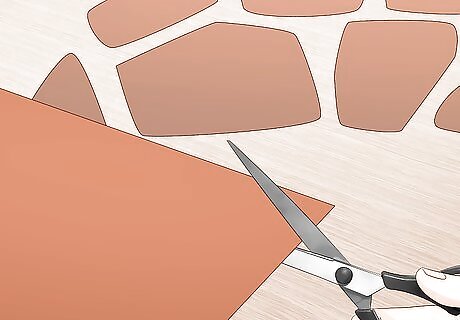
Cut out spots using brown craft paper. Use a sharp pair of scissors to cut out giraffe spots in various shapes and sizes. If desired, you may draw these onto the craft paper before you cut or just cut them out at random. Giraffe spots are usually oddly shaped, but still somewhat circular or oblong. Try looking up images of giraffe spots for inspiration. Make sure to cut out lots of spots. You will need enough to cover the entire costume.
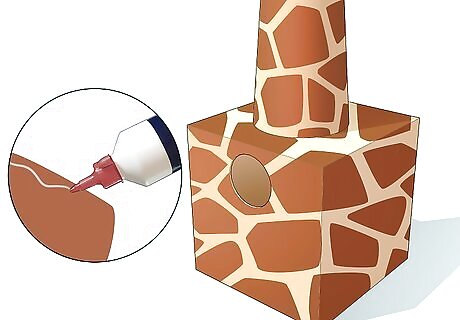
Use white glue to attach the spots onto the giraffe’s neck and body. Use some white glue to apply the spots to the giraffe’s head, neck, and body. Space out each of the spots by about 2 to 3 inches (5.1 to 7.6 cm). This will ensure that there is an even distribution of spots.
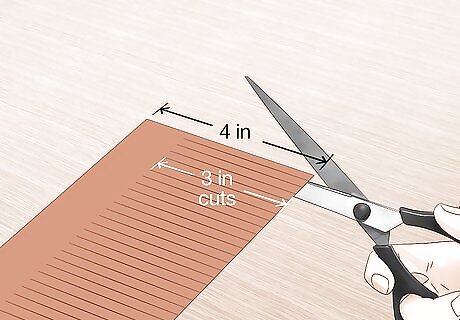
Make fringe in a long strip of brown craft paper for the mane. Cut out a 4 in (10 cm) wide strip of brown craft paper that is long enough to cover the length of the giraffe’s neck. This will be its mane. Then, cut fringe in the strip by making 3 in (7.6 cm) deep cuts in the strip spaced about 0.25 in (0.64 cm) apart. Cut the fringe all the way down the length of the strip.
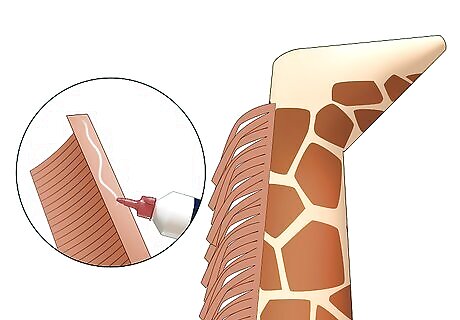
Glue the mane onto the back of the giraffe’s neck. Apply a long thick line of white glue along the back of the giraffe’s neck. Fold the fringed strip where the fringe and solid area of the strip meet. Then, apply the mane by pressing the unfringed area of the strip onto the line of glue.
Decorating the Giraffe’s Head
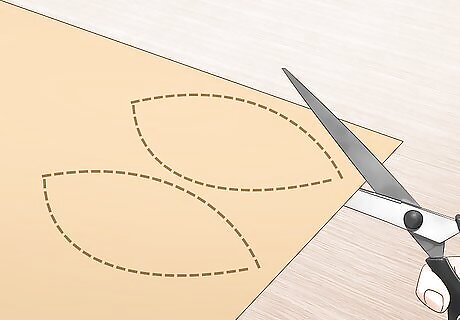
Cut out the ear shapes. Cut out 2 pieces of brown craft paper that look like leaves with 2 pointed ends and 2 rounded sides. The pieces should be about 5 inches (13 cm) long and 3 inches (7.6 cm) wide. Fold over about 0.5 in (1.3 cm) of the bottom of each ear piece.
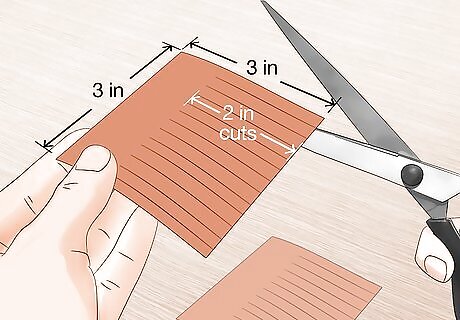
Create 2 eyelashes. Cut out 2 square pieces of brown craft paper that are about 3 by 3 inches (7.6 by 7.6 cm). Then, cut 2 inches (5.1 cm) of fringe along 1 edge of the square leaving 1 in (2.5 cm) of uncut paper beside the fringe. Fold the squares at the base of the fringe. Eyes are optional for this costume. If you want your giraffe to have eyes, then you can paint some on under the eyelashes or make eye cutouts and glue them on under the eyelashes.

Glue the ears and eyelashes onto the giraffe’s head. Apply glue to each of the eyelash pieces and ear pieces where you folded them. Press the pieces onto the giraffe’s head where you want them to go. The ears should be right on top of the head spaced about 1 to 2 inches (2.5 to 5.1 cm) apart. The eyelashes should be 1 to 2 inches (2.5 to 5.1 cm) apart about midway between the top of the head and the tip of the nose.
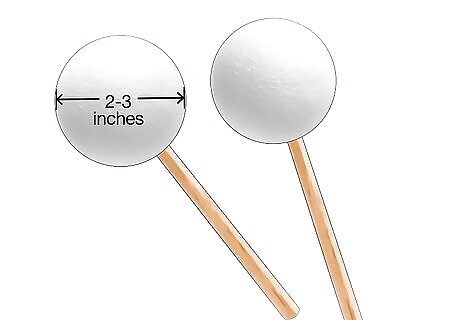
Spear the Styrofoam balls with the chopsticks. You will need 2 Styrofoam balls about 2 to 3 inches (5.1 to 7.6 cm) in diameter. You can get smaller or larger balls depending on how large you want the antennae ends to be. Take a chopstick and insert the pointed end into 1 of the Styrofoam balls. Repeat with the other chopstick and Styrofoam ball.
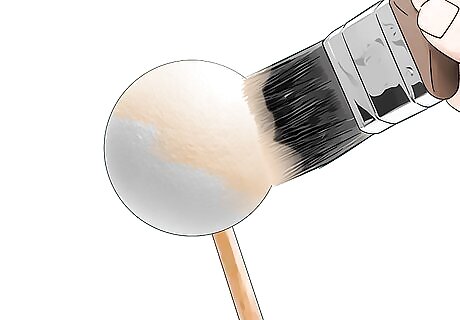
Paint the Styrofoam balls and chopsticks, if desired. You may paint the Styrofoam balls and chopsticks to match the giraffe’s skin, if desired. For example, if you painted the giraffe yellow, then you could paint the Styrofoam balls and chopsticks yellow, too.
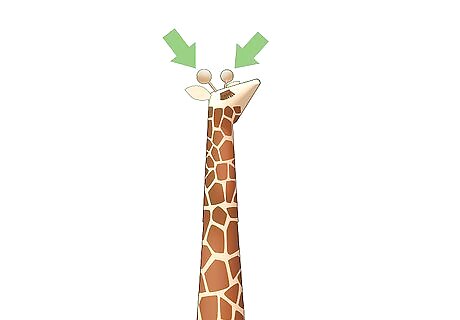
Attach the Styrofoam balls to the head. Poke 2 small holes about 0.5 in (1.3 cm) apart on the top of the giraffe’s head between its ears. Then, insert the wide ends of the chopsticks through the holes. Apply a couple of pieces of masking tape to secure the antennae.
Finishing the Costume
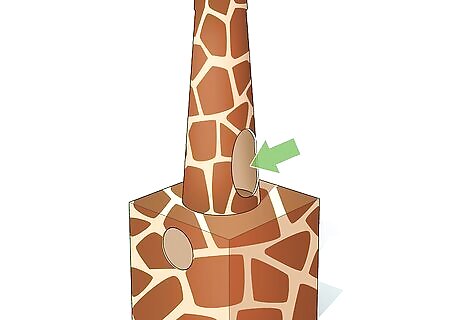
Cut a hole out of the bottom of the neck. Use a sharp pair of scissors to cut a hole in the base of the neck on the front of your giraffe. This is where your face will be visible in the costume, so make sure that the hole is large enough for your face. You can also use an X-Acto knife to cut the hole.
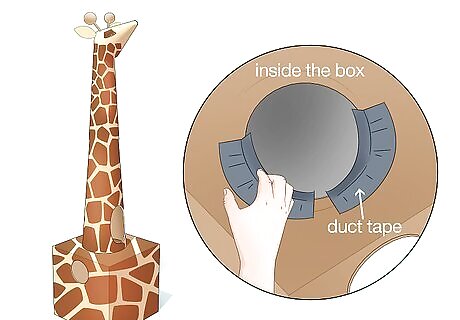
Apply additional tape to secure the pieces. Reinforce any weak spots in the costume from the inside by applying additional masking tape. For example, if there is an area between the neck and body that feels a little loose, then apply a couple of pieces of tape there to reinforce it. Duct tape also works well for reinforcing any weak seams in the costume. It will be hidden on the inside of the costume, so don’t worry if the color does not match.
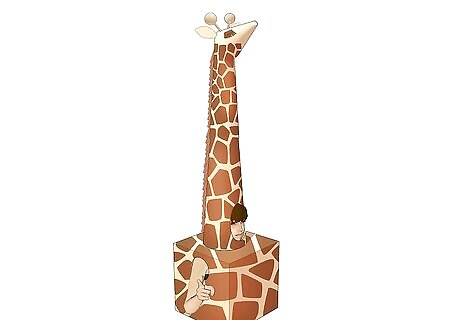
Try the costume on! When your costume is complete and reinforced, try it on and see how it looks! You can wear it alone or you can wear some matching color clothes on the bottom to help blend in, such as a pair of giraffe print leggings. You might even want to apply some face paint to blend in, such as yellow face paint if the giraffe’s body has a yellow base.











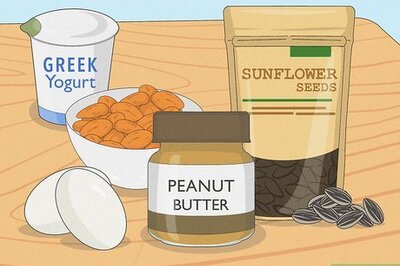

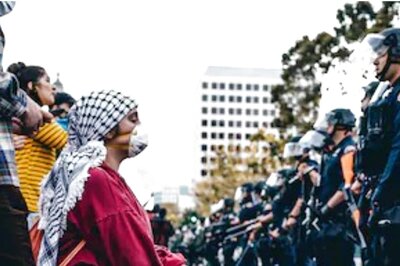





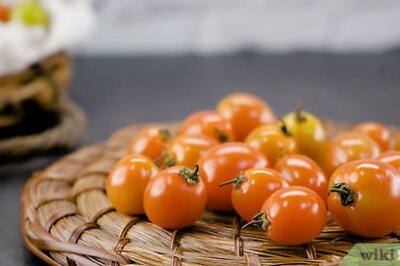
Comments
0 comment